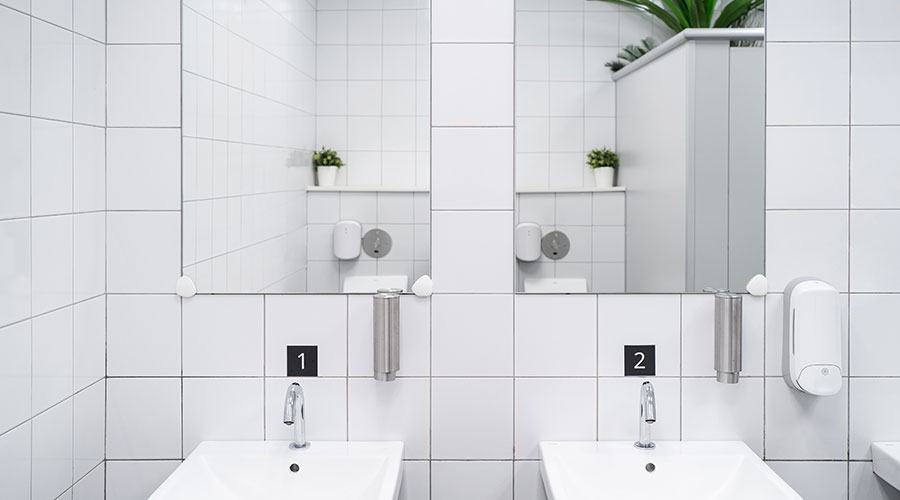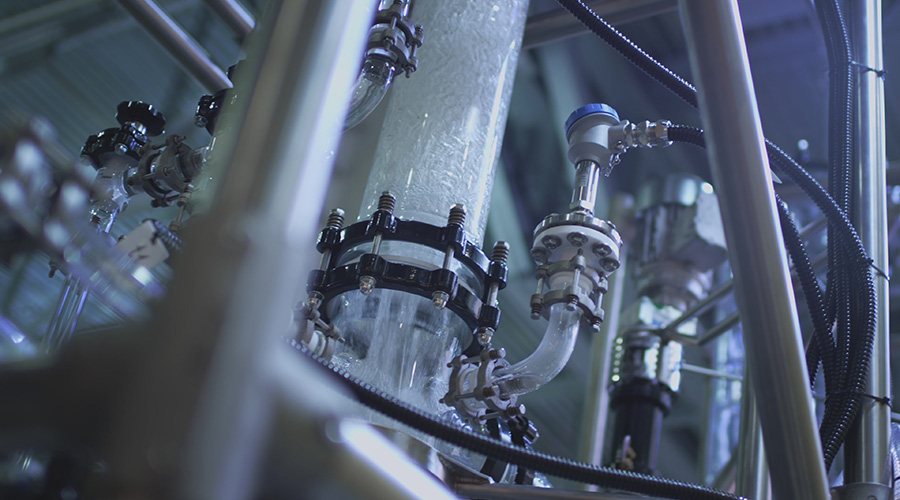Outside of the Mainstream
Waterless urinals, specified and installed strategically, can offer managers an alternative that can ease facility water use and maintenance needs
Waterless urinals have become an appealing option for institutional and commercial facilities in recent years. The need for fixtures that minimize water use and advances in waterless-system technology have combined to create greater interest among managers.
Maintenance and engineering mangers have options when it comes to waterless technology. A closer review of their benefits and drawbacks, as well as additional facility considerations, can help managers determine if waterless urinals are viable products for their buildings.
Waterless Considerations
By law, any urinal manufactured for use in the United States after 1993 must use 1 gallon per flush (gpf) or less. Before 1993, the standard flush rate was 3 gpf. As a result of this change, it is likely that any urinals in a facility more than 10 years old offer substantial opportunity for savings in water, sewer, installation and maintenance costs, since they require no water to flush, no piping, and no flush valves or other control hardware.
Managers have several waterless options to consider, from completely waterless restrooms to individual urinals. Individual urinals are available for retrofitting old trough or individual urinals, and they meet Americans with Disabilities Act Access Guidelines (ADAAG) for both retrofit and new installations.
Benefits and Drawbacks
Waterless urinals use the difference in specific gravity of the trap solution to that of urine to create a liquid seal. The lighter specific gravity of the seal liquid enables it to float on top of the urine while sealing the discharge line and preventing sewer odors from backing up.
The chief benefit of waterless urinals is their lack of water consumption. No water piping is connected to the unit, which keeps down installation and maintenance costs, as well as water and sewer bills. And with no water required, the flush controls, sensors to adjust flow, battery replacement, and other maintenance, such as repairing leaks, go away.
In high-rise buildings, these units can reduce demands on booster pumps enough to avoid costly upgrades or replacements if they currently operate near design limits. And the resulting reduced mineral buildup due to lower water-flow volumes can add years to piping life.
Urinals must meet both building and access codes for public buildings, and waterless urinals can help managers meet this requirement because they tend to be easy to installation. They can be retrofit from either existing trough or individual drain connections. ADA-compliant installations are available for compliance with guidelines when installed according to ADA rough-in, floor-height specifications.
Material costs for waterless-urinal installations also tend to be considerably lower, since the units need no water lines, flush valves, sensors or batteries. In many cases, installers can reuse the existing fixture flange because the fixture size is the same as the one being replaced.
Maintenance costs are also very low. Aside from daily sanitary maintenance — also a requirement for old-style units — the only maintenance costs for waterless units relate to periodically replacing seal traps and adding sealing liquid.
Finally, because waterless urinals are flushless and touchless, they tend to be more sanitary than traditional fixtures. Germs tend to multiply in damp or wet conditions but die in dry conditions. Also, flushing turbulence with water-using units creates an invisible mist of germs, which can become airborne. The drier conditions associated with waterless units, however, can contribute to healthier indoor environments.
Drawbacks
The first cost to convert to a waterless unit can be higher. While a waterless urinal fixture costs about the same as a conventional fixture, managers might want to gain the benefits of water and sewer savings for the next 10 years. In this case, they can incur the cost of early replacement, well before existing fixtures might have completed their useful lives.
For facilities with relatively few urinals, low usage, and low water and sewer costs, waterless urinals might not offer short-term payback. For new installations of this type, however, the economics are favorable, since installation cost is lower than those for the current 1-gpf units, and water use is lower.
Finally, all waterless urinals might not comply with ANSI Standard Z124.9, so it is a good idea to consider this limitation when specifying fixtures.
Making a Decision
A variety of facility types have successfully installed waterless urinals in recent years. For new installations, managers in all facilities regardless of size should investigate waterless urinals.
For retrofit projects, facility size as noted above might make a difference in the payback. Managers in larger facilities that have many urinals, high water-use levels, and high water and sewer rates definitely should look at this option when looking for ways to reduce operating costs.
A waterless urinal is a viable option for hospitals, schools, commercial and government buildings. Government agencies such as military bases, the U.S. Postal Service, NASA, national parks, and General Services Administration (GSA) buildings use waterless urinals that conform to U.S. Department of Defense Standard Z124.9-D2D4X2X1.
Several government energy-efficiency programs — including ENERGYSTAR® — also mandate that agencies buy products that are in the upper 25 percent of energy efficiency compared to other products designed for the same purpose.
For urinals, the recommended flush rate under the Federal Energy Management Program (FEMP) is 1 gpf, while many fixtures installed before 1992 have a flush rate of 3 gpf. The published average annual water savings for waterless urinals is $90 per fixture over old-style 3.0 gpf units.
Analyzing Costs and Savings
Managers can calculate the cost of existing old-style 1-, 1.5-, or 3-gpf units urinals to determine whether cost savings exist in switching to waterless units. The information needed and averages used by FEMP to illustrate potential savings are follows:
1. Flushes per day: 30
2. Gallons per flush: 3
3. Days of usage per year: 260
4. Water and sewer treatment combined rate: $4 per 1,000 gallons, though this figure might be as high as $10.
The resulting water use per year is 1 x 2 x 3, or 23,400 gallons. The water and sewer costs are equal to 23,400 gallons per 1,000 x $4 per 100 gallons, or about $93.
The 10-year water and sewer savings generated by early replacement of 3 gpf urinals is $93 multiplied by 10, or $930.
In a facility with 30 urinals, the total 10-year water and sewer savings are $930 multiplied by 30, or $27,900, which would cover the cost of many waterless urinals, since that cost is about the same as that of a conventional urinal.
By comparing water, sewer and maintenance costs for conventional units with the same costs for the waterless units, managers can determine the return on investment. Calculate this figure by comparing the water rate above of $4 per 100 gallons with the local water rate. Take the ratio of the local rate — say $5 per 100 gallons — to the government average of $4: $5/$4 = 1.25. Multiply this ratio by the savings above — $27,900 x 1.25 = $34,875 — to determine the 10-year savings at a rate of $5 per 1,000 gallons.
Other costs managers must consider are maintenance costs for flush-valve repair, blockage, backups and overflows, as well as daily sanitation maintenance. The latter cost is about the same for both the flush-type and waterless urinals.
Installation labor for waterless urinals often is minimal. It takes from 45 minutes to 2 hours to retrofit from an existing rough-in for the sewer plumbing. A new installation takes 15 minutes from the new rough-in. The seal trap is installed in the fixture and can only be removed with a special two-prong tool that prevents tampering.
The published price for the trap that holds the liquid seal is about $5-6, and the seal liquid is $0.50 per ounce. An ounce of seal fluid is good for about 500 flushes, or about two-and-a-half weeks, on average.
All things considered, maintenance and engineering managers are likely to give stronger consideration of installations of this sort, replacing conventional water-type urinals with new, cost-effective, low-maintenance waterless urinals.
Plumbing Resources
Maintenance and engineering managers have a host of resources on plumbing system specification and maintenance issues in general and, in some cases, waterless urinals. They include the following:
| • |
American National Standards Institute (ANSI)
1430 Broadway
New York, NY 10018 |
• |
U.S. Department of Energy Federal Energy Management Program
(800) 363-3732 (FEMP) |
| • |
American Society for Testing Materials (ASTM)
1916 Race St.
Philadelphia, PA 19103 |
• |
International Association of Plumbing and Mechanical Officials
20001 Walnut Drive S.
Walnut, CA 91789-8449 |
| • |
American Society of Plumbing Engineers
3617 Thousand Oaks Blvd., Suite 210
Westlake Village, CA, 91362
(805) 495-7120 |
• |
Underwriter’s Laboratories (UL)
333 Pfingsten Road
Northbrook, IL 60062 |
| • |
American Society of Sanitary Engineers
28901 Clemens Road, Suite 100
Westlake, OH 44145
(216) 835-3040 |
• |
U.S. Environmental Protection Agency WasteWise Program |
| • |
American Water Works Association Waterwiser program
(800) 559-9855 |
• |
Productivity Network Innovations, L.L.C., Maintenance Manager's Standard Manual, 2nd Edition
Westerkamp, Thomas A.,
Prentice Hall, 1997 |
| • |
Americans with Disabilities Act, Checklist for Readily Achievable Barrier Removal for Existing Facilities
(800) 949-4ADA |
|
|
Related Topics:












